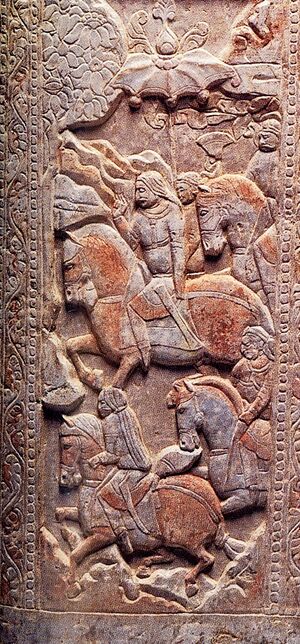معركة بخارى
| معركة گول-زريون | |||||||||
|---|---|---|---|---|---|---|---|---|---|
| جزء من الحروب الفارسية-الهفتالية | |||||||||
 فرسان تورك على أريكة ميهو الجنائزية، ح.570 م.[1] | |||||||||
| |||||||||
| المتحاربون | |||||||||
|
الإمبراطورية الساسانية الخاقانية التوركية الأولى | الإمبراطورية الهفتالية | ||||||||
| القادة والزعماء | |||||||||
|
كسرى الأول إيستمي | Ghadfar | ||||||||
الموقع داخل West and Central Asia | |||||||||
معركة گول-زرّيون،[3] Battle of Gol-Zarriun وتُعرف أيضاً بإسم معركة بخارى، نشبت في حوالي 560 حين تحالفت الإمبراطورية الساسانية مع الخاقانية التوركية الأولى ضد الإمبراطورية الهفتالية.
السياق
In 484, Peroz I, the grandfather of Khosrow I Anushirvan (ح. 531–579), was killed in the Battle of Herat (484) by the Hephthalites and allowed them to annex much of خراسان من الساسانيين.
After a stable peace agreement with the Byzantines in the west, Khosrow I was able to focus his attention on the Eastern Hephthalites and avenge the death of his grandfather. Even with the growth of Sasanian military power under Khosrow's reforms, the Sasanians were still uneasy at the prospect of attacking the Hephthalites on their own and sought allies. Their answer came in the form of the Göktürks incursion into Central Asia.[4] The movement of Turkic people into Central Asia quickly made them natural enemies and competitors to the Hephthalites.
The Hephthalites possessed military power, but they lacked the organization to fight on multiple fronts. According to the account of Firdausi in the Shahname, the Hephthalites were supported by troops from Balkh, Shughnan, Amol, Zamm, Khuttal, Termez and Washgird.[5] The Sasanians and the Turks made an alliance and launched a two-pronged attack on the Hephthalites, taking advantage of their disorganization and disunity. As a result, the Turks took the territory north of the Oxus River, while the Sasanians annexed the land south of the river.[6]
الأعقاب
The Hephthalite Empire was destroyed after the battle, and broke into several minor kingdoms, such as the one ruled by the Hephthalite prince Faghanish in Chaghaniyan. Ghadfar and what was left of his men fled southward to Sasanian territory, where they took refuge.[7] Meanwhile, the Turkic Khagan Sinjibu reached an agreement with the Hephthalite nobility, and appointed Faghanish as the new Hephthalite king.[8]
This was much to the dislike of Khosrow I, who considered the Turkic collaboration with the Hephthalites to pose a danger for his rule in the east, and thus marched towards the Sasanian-Turkic border in Gurgan. When he reached the place, he was met by a Turkic delegate of Sinjibu that presented him gifts.[8] There Khosrow asserted his authority and military potency, and persuaded the Turks to make an alliance with him. The alliance contained a treaty that made it obligatory for Faghanish to be sent to the Sasanian court in Ctesiphon and gain the approval of Khosrow for his status as Hephthalite king.[8] Faghanish and his kingdom of Chaghaniyan thus became a vassal of the Sasanian Empire, which set the Oxus as the eastern frontier of the Sasanians and Turks.[9][10] However, friendly relations between the Turks and the Sasanians quickly deteriorated after that. Both the Turks and the Sasanians wanted to dominate the Silk Road and the trade between the west and the far east.[6] In 568, a Turkish ambassador was sent to the Byzantine Empire to propose an alliance and a two-pronged attack on the Sassanian Empire, but nothing came of this.[11]
المراجع
- ^ Inagaki, Hajime. Galleries and Works of the MIHO MUSEUM. Miho Museum. p. 121, panel 8.
- ^ Bivar 2003, pp. 198–201.
- ^ Rezakhani 2017, p. 141.
- ^ Baumer 2018, p. 97–99.
- ^ Dani, Ahmad Hasan; Litvinsky, B. A. (January 1996). History of Civilizations of Central Asia: The crossroads of civilizations, A.D. 250 to 750 (in الإنجليزية). UNESCO. p. 176. ISBN 978-92-3-103211-0.
- ^ أ ب Frye 1984.
- ^ Rezakhani 2017, pp. 141-142.
- ^ أ ب ت Rezakhani 2017, p. 142.
- ^ Litvinsky & Dani 1996, pp. 176-177.
- ^ Bivar 2003, pp. 198-201.
- ^ Dingas & Winter 2007, p. 115.
المصادر
- Baumer, Christoph (18 April 2018). The History of Central Asia. Bloomsbury Publishing. ISBN 978-1-83860-868-2.. 4-volume set.
- Dingas, Beate; Winter, Engelbert (2007). Rome and Persia in Late Antiquity. Cambridge University Press. p. 38.
- Sims-Williams, Nicholas (2009). "Kadagistān". Encyclopaedia Iranica, Vol. XV, Fasc. 3. London et al. pp. 324–325.
{{cite encyclopedia}}: CS1 maint: location missing publisher (link) - Rezakhani, Khodadad (2017). ReOrienting the Sasanians: East Iran in Late Antiquity. Edinburgh University Press. pp. 1–256. ISBN 9781474400305.
- Frye, Richard Nelson (1984). The History of Ancient Iran. C.H.Beck. pp. 1–411. ISBN 9783406093975.
The history of ancient iran.
- Shahbazi, A. Sh. (1988). "Bahrām VI Čōbīn". Encyclopaedia Iranica, Vol. III, Fasc. 5. London et al. pp. 514–522.
{{cite encyclopedia}}: CS1 maint: location missing publisher (link) - Howard-Johnston, James. "ḴOSROW II". Encyclopaedia Iranica, Online Edition.
- Litvinsky, B. A.; Dani, Ahmad Hasan (1996). History of Civilizations of Central Asia: The crossroads of civilizations, A.D. 250 to 750. UNESCO. pp. 1–569. ISBN 9789231032110.
- Bivar, A. D. H. (2003). "Hephthalites". Encyclopaedia Iranica, Vol. XII, Fasc. 2. London et al. pp. 198–201.
{{cite encyclopedia}}: CS1 maint: location missing publisher (link)
- Pages using gadget WikiMiniAtlas
- Short description is different from Wikidata
- Coordinates on Wikidata
- CS1 maint: location missing publisher
- 560s conflicts
- 560
- Battles involving the Hephthalites
- Battles involving the Sasanian Empire
- Military history of the Göktürks
- Khosrow I
- Hephthalite–Sasanian Wars
- 6th century in Iran
- Wars of Khosrow I
